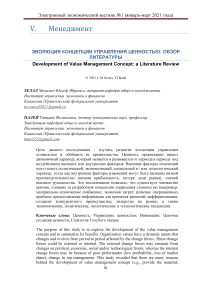Эволюция концепции управления ценностью: обзор литературы
Автор: Хелал Мохамед Юссеф Ибрахим, Палей Татьяна Феликсовна
Журнал: Электронный экономический вестник Татарстана @eenrt
Рубрика: Менеджмент
Статья в выпуске: 1, 2021 года.
Бесплатный доступ
Цель данного исследования - изучить развитие концепции управления стоимостью и обобщить ее преимущества. Ценность организации имеют динамичный характер, который меняется и развивается от периода к периоду под воздействием внешних или внутренних факторов. Внешние факторы изменений могут иметь политический, экономический, социальный и / или технологический характер, тогда как внутренние факторы изменений могут быть вызваны низкой производительностью (низкая прибыльность, потеря доли рынка), сменой высшего руководства. Это исследование показало, что существует множество причин, стоящих за разработкой концепции управления стоимостью (например, материально-техническое снабжение; экономия затрат; решение операционных проблем; предоставление информации для принятия решений; дифференциация; создание конкурентного преимущества; лидерство на рынке; а также экономические, политические, экологические и технологические тенденции).
Ценность, управление ценностью, инновации, цепочка создания ценности, стратегия голубого океана
Короткий адрес: https://sciup.org/143178070
IDR: 143178070
Список литературы Эволюция концепции управления ценностью: обзор литературы
- Abidin, N. Z. (2005). Using value management to improve the consideration of sustainability within construction (Doctoral dissertation, Loughborough University).
- Abidin, N.Z., and Pasquire, C.L., (2007). Revolutionize value management: a mode towards sustainability. Int. J. Proj. Manag. 25 (3), 275–282.
- Aghimien, D. O., & Oke, A. E. (2015). Application of value management to selected construction projects in Nigeria. Developing Country Studies, 5(17), 8-14.
- Aghimien, D. O., Oke, A. E., and Aigbavboa, C. O. (2018). Barriers to the adoption of value management in developing countries. Engineering, Construction and Architectural Management.
- Bovel, D., & Martha, J. (2000). From supply chain to value net. Journal of Business Strategy, 21(4), 25-25.
- Cha, H.S., and O'Connor, J.T., (2005). Optimizing implementation of value management processes for capital projects. J. Constr. Eng. Manag. 131 (2), 239–251.
- Dumond, E. J. (2000). Value management: an underlying framework. International Journal of Operations & Production Management.
- Emmitt, S. (2007). Value and Risk Management: A Guide to Best Practice. Architectural Engineering and Design Management, 3(1), 76-77.
- Fearne, A., Martinez, M. G., & Dent, B. (2012). Dimensions of sustainable value chains: implications for value chain analysis. Supply Chain Management: An International Journal.
- Howe, L. D. (2003). A value management approach to strategy.
- Institute of Value Management (2002), What is Value Management, Available at: https://ivm.org.uk/value-management/ [accessed December 8, 2020].
- Invernizzi, D. C., Locatelli, G., Grönqvist, M., and Brookes, N. J. (2019). Applying value management when it seems that there is no value to be managed: the case of nuclear decommissioning. International Journal of Project Management, 37(5), 668-683.
- Jayaraman, V., & Luo, Y. (2007). Creating competitive advantages through new value creation: a reverse logistics perspective. Academy of management perspectives, 21(2), 56-73.
- Kelly, J., and Male, S. (2003). Value management in design and construction. Routledge.
- Kim, W. C. and Mauborgne, R. (2005). Blue ocean strategy. Gildan Media.
- McPhee, W., & Wheeler, D. (2006). Making the case for the added-value chain. Strategy & Leadership.
- Nasir, N., Mohd Nawi, M. N., Zulhumadi, F., Anuar, H. S., and Radzuan, K. (2016). Value management: a systematic approach for improving time performance in construction projects. International Journal of Supply Chain Management (IJSCM), 5(4), 195-200.
- Nawi, M. N. M., Nifa, F. A. A., and Ibrahim, S. H. (2015). Building sustainable design performance through integrated value management practice. In InCIEC 2014 (pp. 211-218). Springer, Singapore.
- Palmer, A., Kelly, J. and Male, S. (1996), “Holistic appraisal of value engineering in construction in United States”, Construction Engineering and Management, Vol. 122 No. 4, pp. 324-326.
- Porter, M. E. (1991). Towards a dynamic theory of strategy. Strategic management journal, 12(S2), 95-117.
- Porter, Michael E. (1985). Competitive Advantage: Creating and Sustaining Superior Performance. New York.: Simon and Schuster.
- Simatupang, T. M., Piboonrungroj, P., & Williams, S. J. (2017). The emergence of value chain thinking. International Journal of value chain management, 8(1), 40-57.
- Singh, P. K. (2012). Management of Business Processes Can Help an Organization Achieve Competitive Advantage. International Management Review, 8(2).
- Tahir, M. Z., Nawi, M. N. M., and Ibrahim, A. (2016). Value management (VM): a strategic approach for improving energy efficiency. International Journal of Supply Chain Management, 5(4), 201-208.
- Thiry, M. (2013). Framework for Value Management Practice. Project Management Institute.
- Venkataraman, R. R., & Pinto, J. K. (2011). Cost and value management in projects. John Wiley & Sons.
- Walters, D. (2002). Operations strategy: A value chain approach. Macmillan International Higher Education.
- Whyte, A., & Cammarano, C. (2012). Value management in infrastructure projects in Western Australia: Techniques and staging. In Proceedings of the 28th Annual ARCOM Conference (pp. 797-806). ARCOM, Association of Researchers in Construction Management.
- Zhang, Q., Vonderembse, M. A., & Lim, J. S. (2002). Value chain flexibility: a dichotomy of competence and capability. International journal of production research, 40(3), 561-583.
- Zwikael, O., and Smyrk, J., (2012). A general framework for gauging the performance of initiatives to enhance organizational value. Br. J. Manag. 23, 6–22.


